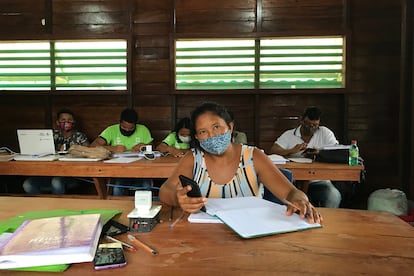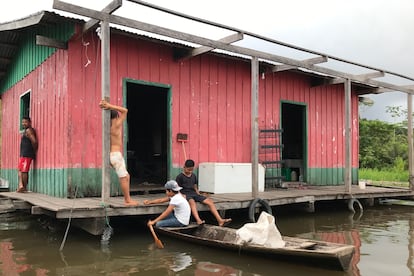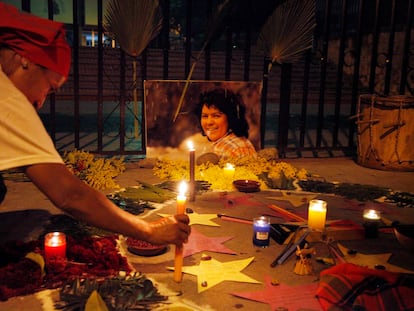Guardians of the Amazon rainforest want their slice of the global appetite for acai berries
The fashionable health food grows in villages like Punã in Brazil, where incentives are in place to prevent deforestation and add value to local produce


Açaí, marketed in the English-speaking world as acai berries, is the latest trend among health food enthusiasts. A fruit that grows in the tops of palm trees in villages such as Punã , deep in the Amazon rainforest, has gained fame in the four corners of the world because it contains antioxidants, nutrients and energy-giving properties. Turned into a dense purple liquid, it is consumed in a variety of ways by those who harvest it here: with fish, with chicken, mixed with cassava flour, and as a dessert, with or without sugar. Some even prefer a pinch of salt. “We pick it and eat in on the same day because it goes off quickly,” says 23-year-old Ariel de Souza. A recently restored building dating from the rubber rush, 100 years ago, presides over this small location on the banks of the Amazon river.
This is one of the most remote locations on the planet, a singular place dotted with family farming plots surrounded by lush vegetation. The days are governed by the rising and setting of the sun and the people live on basic diets and have few possessions. They also have enormous television sets and when dusk falls, girls and boys play soccer while teenagers turn to their Instagram accounts.
Açaí was a subsistence staple until the dawning of what De Souza describes as “the revolution”: electricity, refrigerators. The revolution also gave açaí a new identity, as well as to these hamlets perched on the banks of the world’s mightiest river, founded by Brazilians from other parts of the country who came here to work in the rubber industry at the end of the 19th century. “It was always nothing more than pure sustenance, btu a few years ago açaí became a business,” says De Souza’s 46-year-old neighbor, Rocima Fração.

What Fração means by “business” is not the açaí-selling stalls that have sprung up across half the world. Instead it is something more modest, but which has also brought unprecedented wealth to the farmers who inhabit this small village of wooden houses, resulting in secondary school for the children and a wi-fi internet connection for everybody.
Now the Punã farmers produce açaí for sale to other nearby villages along the meandering path of the Amazon, and for the city. The nearest town, Tefé, is an hour away by boat due to the highest rise in water levels in the past 120 years, which allows vessels to take shortcuts. Manaus is two nights and a day of navigation downstream. The rivers are equivalent to highways in an enchanting landscape that nevertheless turns the movement of goods and people into a nightmare. Sunsets may be breathtaking, but this beautiful expanse also provides camouflage for activity along some of the region’s most important drug-trafficking routes.
Although the untrained eye of the city-dweller may believe that little has changed here over the past few centuries, locals speak about animal species they no longer see, river beaches that become vaster in the dry season and swelling waters when the rains come.

The well-being of the planet depends in no small part on the 150 families who live in Punã – a sizeable village in comparison to its neighbors – as well as on other nearby communities and the indigenous tribes of the Amazon, because they all play an essential role in the preservation of the largest rainforest in the world.
Fração remembers when a kilogram of açaí netted six centavos ($0.01). “You too?” she asks another resident of Punã, who replies: “When I started out it was 12 centavos.” It seems as though they are talking about the ancient past, about a time they have no personal knowledge of. Nowadays a kilo of açaí retails at five Brazilian reales ($1). However, everything is regulated so that the business is ecologically sustainable. The Punã community has joined the Foundation for Amazon Sustainability (FAS) in order to cut out the middlemen who eat into the profits of açaí producers and those who trade in the giant pirarucu fish and cassava flour, a dietary staple as essential as bread in the US or tortillas in Mexico. FAS, which invited EL PAÍS to visit Punã, has a diverse range of projects running in more than 500 villages in the region, driving sustainable businesses that contribute to keeping the rainforest intact and improving the day-to-day lives of those who protect it.
Another local product, pirarucu, is one of the biggest success stories in the Amazon. These huge fish were on the verge of extinction when the arrival of motorboats gave the fishing industry a boost. But an alliance between science and tradition produced a turnaround that eventually made pirarucu a delicacy that now features on the menus of expensive restaurants in Río de Janeiro and São Paulo as well as overseas. The fish’s smooth skin has also been crafted into chic handbags that fly off boutique shelves due to their tag of sustainability.
A researcher at the Mamirauá nature reserve, which can be seen on the horizon from Punã on the opposite bank of the river, discovered that local fisherman possessed an effective ancestral method for counting these red-scaled fish, which curiously come up to the surface every 20 minutes to take a gulp of air. This fleeting moment is enough for traditional fishermen to take stock and determine if the pirarucu are adults or juveniles, explains Pedro Nassar of the Mamirauá Institute. This traditional counting method, which is incredibly precise, has formed the basis of a quota system that has achieved the survival and growth of a species that was in danger of disappearing.
“The pirarucu is 100% organic; it feeds on wild fruit,” says Raimon Rodrigues, the 28-year-old president of the neighborhood association of the Mamirauá reserve. “The margin of error on the count is between 2% and 5% and we can fish 30% of the adults to maintain the stock.” Rodrigues’ father was a fisherman; Raimon studied at university but returned to the village. Now he defends the interests of his people, including 1,100 pirarucu fishermen who are permitted to fish all year round to feed their families but only have a three-month window to fish for profit. Together, they are planning to buy a boat with a deck freezer.

Açaí, cassava and pirarucu are sources of legitimate income in a remote region where the machinery of state is scarce and illegal businesses are lucrative. A family can earn around 2,000 reales (€320, $390) from an açaí plantation, almost 3,000 reales from cassava flour and 3,700 reales by fishing for pirarucu. But the routes from this corner of the Amazon to the client are torturous and plagued by voracious intermediaries. “We want you to make yourselves rich here, we want you to prosper; it’s like you’re sitting on a huge gold mine,” Virgilio Viana, the 60-year-old head of the FAS told a few dozen Punã residents who are the first-ever students in a course on sustainable management run by the organization in conjunction with the Amazonas state government. Although everybody in Punã has been vaccinated, face masks remain mandatory amid the coronavirus pandemic in Brazil.
The idea is to develop projects that will allow villagers to prosper on the lands of their forefathers while also stopping the exodus to the city. In Punã, the children say that the big plan for the weekend is going swimming in the river. Among the students enrolled in the course are several youngsters who have just left school, but also courageous adults like 34-year-old Luciane do Nascimento, who has eight children and two grandchildren and is excited about taking up her studies again. “Growing crops without cutting down the forest is harder work, but it can be done,” she says. Illegal logging and environmental crimes are deep-rooted, but these activities have increased hugely since Jair Bolsonaro came to power. For the Brazilian president, the environment is an obstacle that stands in the way of squeezing profits out the vast natural resources available and ending poverty in the Amazon region.
Francisca Miguel is a friendly, charismatic 63-year-old whose glasses refuse to sit symmetrically on her nose. She grew up a time when the boats that traversed the river toward the village were powered by steam. She remembers the first time she heard someone talk about sustainability. It was at the same time some years ago when the first small payment arrived in the village in exchange for not cutting down trees. “Ever since then I have not done it,” she says solemnly. Those payments went some way to paying the bills, but its greatest effect was raising awareness among the locals. Little by little, the idea took root that “the forest is more valuable standing up than destroyed,” a slogan that Viana used to repeat before the FAS was founded, when he was serving as secretary for the environment and sustainable development in the state government. It is a phrase that environmentalists, international organizations and even some soy producers have adopted.

When Francisca was a child, rubber was already history but the owner of the plantations still managed to enrich himself by keeping the villagers in a state of semi-slavery. She was raised as a servant to the household of a man named Gama, who held the monopoly over all goods that were bought and sold in Punã. Anybody who tried to trade behind his back was exiled from the village. After decades of back-breaking work picking cassava and using up her hands to make flour in order to raise her eight children, Francisca is still fighting against these middlemen who buy local produce on the cheap and then sell it on at inflated prices to their customers.
Francisca and her neighbors are engaged in a plethora of projects to make their sustainable businesses more profitable. Although her husband keeps asking her to retire, she has no intention of doing so. “If I don’t make cassava flour, I’ll go mad,” she says as she shakes a sieve. She has been putting all of her energy into adapting to the production regulations that are demanded by the coveted Protected Designation of Origin label, which will provide more added value to the products the people of Punã make and package with their own brand name.
Viana wants to offer new horizons to the Brazilians of the Amazon rainforest. “Too often the external viewpoint, from the south of Brazil and from abroad, is that deforestation is a matter for the police, but what I believe is that we need to look after the people that look after the rainforest. That is another slogan that I came up with. There is no point in investing in the bioeconomy if the locals have no drinking water or children are forced into prostitution.”
English version by Rob Train.
Tu suscripción se está usando en otro dispositivo
¿Quieres añadir otro usuario a tu suscripción?
Si continúas leyendo en este dispositivo, no se podrá leer en el otro.
FlechaTu suscripción se está usando en otro dispositivo y solo puedes acceder a EL PAÍS desde un dispositivo a la vez.
Si quieres compartir tu cuenta, cambia tu suscripción a la modalidad Premium, así podrás añadir otro usuario. Cada uno accederá con su propia cuenta de email, lo que os permitirá personalizar vuestra experiencia en EL PAÍS.
¿Tienes una suscripción de empresa? Accede aquí para contratar más cuentas.
En el caso de no saber quién está usando tu cuenta, te recomendamos cambiar tu contraseña aquí.
Si decides continuar compartiendo tu cuenta, este mensaje se mostrará en tu dispositivo y en el de la otra persona que está usando tu cuenta de forma indefinida, afectando a tu experiencia de lectura. Puedes consultar aquí los términos y condiciones de la suscripción digital.
More information
Archived In
Últimas noticias
Most viewed
- Sinaloa Cartel war is taking its toll on Los Chapitos
- Oona Chaplin: ‘I told James Cameron that I was living in a treehouse and starting a permaculture project with a friend’
- Reinhard Genzel, Nobel laureate in physics: ‘One-minute videos will never give you the truth’
- Why the price of coffee has skyrocketed: from Brazilian plantations to specialty coffee houses
- Silver prices are going crazy: This is what’s fueling the rally










































